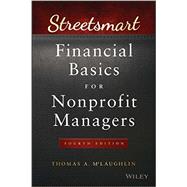Let's be honest. Most books about financial management are densely written, heavy on jargon, and light on practicality. Expert financial consultant and author Tom McLaughlin takes a different approach with his fourth edition of Streetsmart Financial Basics for Nonprofit Managers. This comprehensive guide provides effective, easy-to-use tips, tools, resources, and analyses.
The light, humorous tone in Streetsmart Financial Basics for Nonprofit Managers makes it an accessible resource for nonprofit executives, board members, students, and those new to the field. This book forgoes useless, pretentious verbiage in order to outline real-world strategies that work. This edition includes:
- New insights, updates, vignettes, case studies, and examples to deal with the implications of nonprofit financial management
- An examination of nonprofit business models in relation to growing demands from the government and other funders
- How to construct business plans for virtually any nonprofit entity
- Customizable resources—including financial worksheets, forms, and Excel templates to help nonprofit managers complete their day to day assignments
- A guided tour through common aspects of nonprofit management, such as financial analysis, accounting, and operations
Practical and informative, Streetsmart Financial Basics for Nonprofit Managers is the go-to financial management reference for nonprofit managers, boards of directors, and funders.









